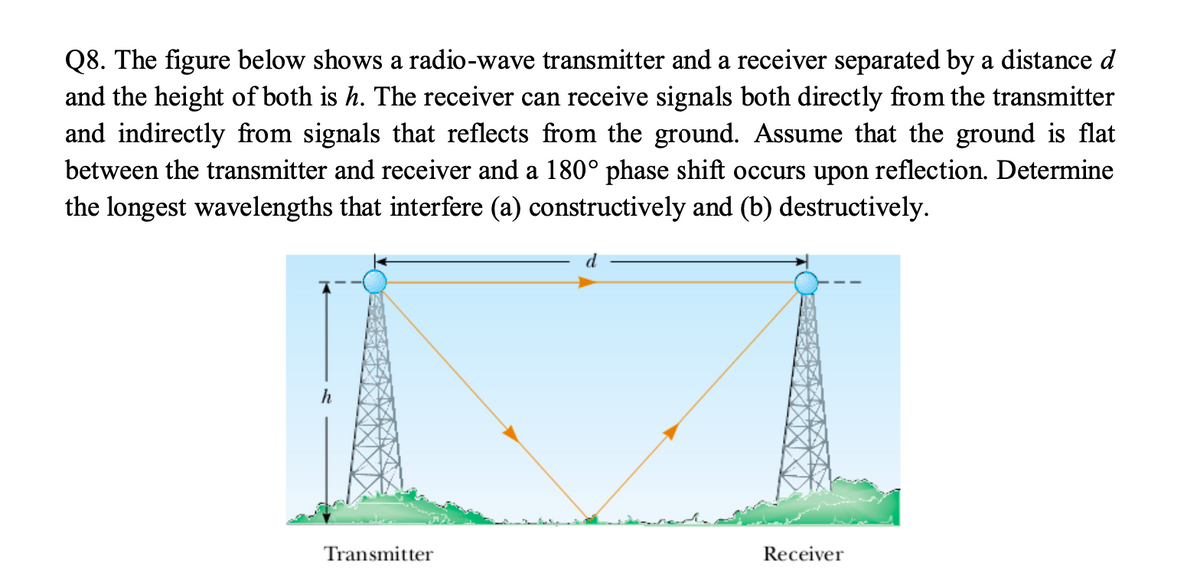The figure below shows a radio-wave transmitter and a receiver separated by a distance d and the height of both is h. The receiver can receive signals both directly from the transmitter and indirectly from signals that reflects from the ground. Assume that the ground is flat between the transmitter and receiver and a 180° phase shift occurs upon reflection. Determine the longest wavelengths that interfere (a) constructively and (b) destructively
The figure below shows a radio-wave transmitter and a receiver separated by a distance d and the height of both is h. The receiver can receive signals both directly from the transmitter and indirectly from signals that reflects from the ground. Assume that the ground is flat between the transmitter and receiver and a 180° phase shift occurs upon reflection. Determine the longest wavelengths that interfere (a) constructively and (b) destructively
University Physics Volume 3
17th Edition
ISBN:9781938168185
Author:William Moebs, Jeff Sanny
Publisher:William Moebs, Jeff Sanny
Chapter3: Interference
Section: Chapter Questions
Problem 12CQ: An inventor notices that a soap bubble is dark at its thinnest and realizes that destructive...
Related questions
Question
The figure below shows a radio-wave transmitter and a receiver separated by a distance d and the height of both is h. The receiver can receive signals both directly from the transmitter and indirectly from signals that reflects from the ground. Assume that the ground is flat between the transmitter and receiver and a 180° phase shift occurs upon reflection. Determine the longest wavelengths that interfere (a) constructively and (b) destructively

Transcribed Image Text:Q8. The figure below shows a radio-wave transmitter and a receiver separated by a distance d
and the height of both is
and indirectly from signals that reflects from the ground. Assume that the ground is flat
between the transmitter and receiver and a 180° phase shift occurs upon reflection. Determine
the longest wavelengths that interfere (a) constructively and (b) destructively.
The receiver can receive signals both directly from the transmitter
Transmitter
Receiver
Expert Solution
This question has been solved!
Explore an expertly crafted, step-by-step solution for a thorough understanding of key concepts.
This is a popular solution!
Trending now
This is a popular solution!
Step by step
Solved in 3 steps

Knowledge Booster
Learn more about
Need a deep-dive on the concept behind this application? Look no further. Learn more about this topic, physics and related others by exploring similar questions and additional content below.Recommended textbooks for you

University Physics Volume 3
Physics
ISBN:
9781938168185
Author:
William Moebs, Jeff Sanny
Publisher:
OpenStax

Physics for Scientists and Engineers: Foundations…
Physics
ISBN:
9781133939146
Author:
Katz, Debora M.
Publisher:
Cengage Learning

Physics for Scientists and Engineers
Physics
ISBN:
9781337553278
Author:
Raymond A. Serway, John W. Jewett
Publisher:
Cengage Learning

University Physics Volume 3
Physics
ISBN:
9781938168185
Author:
William Moebs, Jeff Sanny
Publisher:
OpenStax

Physics for Scientists and Engineers: Foundations…
Physics
ISBN:
9781133939146
Author:
Katz, Debora M.
Publisher:
Cengage Learning

Physics for Scientists and Engineers
Physics
ISBN:
9781337553278
Author:
Raymond A. Serway, John W. Jewett
Publisher:
Cengage Learning

Physics for Scientists and Engineers with Modern …
Physics
ISBN:
9781337553292
Author:
Raymond A. Serway, John W. Jewett
Publisher:
Cengage Learning

College Physics
Physics
ISBN:
9781285737027
Author:
Raymond A. Serway, Chris Vuille
Publisher:
Cengage Learning